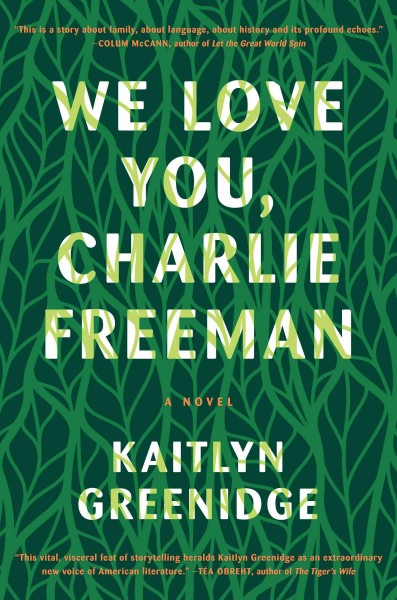by Andrew Hedglin
We Love You, Charlie Freeman by Kaitlyn Greenidge starts with an atmosphere of foreboding. I was already worried when I read the set-up on the back cover of the book: a black family, the Freemans, is hired by the Toneybee-Leroy Institute for Great Ape Research to teach sign language to a chimpanzee named Charlie and raise him as their own.
by Kaitlyn Greenidge starts with an atmosphere of foreboding. I was already worried when I read the set-up on the back cover of the book: a black family, the Freemans, is hired by the Toneybee-Leroy Institute for Great Ape Research to teach sign language to a chimpanzee named Charlie and raise him as their own.
I don’t think you have to know very much about the history of American race relations to be concerned about that problematic request, but Laurel, the mother of the Freemans and an outrageous optimist, views it as a challenge. Laurel, as the only child of the only black family in the Maine wilderness, learns sign language when words fail to encapsulate the isolation that she experiences.
The story is told from multiple points of view, but two perspectives dominate and are granted a first-person voice: Charlotte, the older daughter of the Freemans, and Nymphadora, a spinster schoolteacher and member of a black secret society in the 1920s whose story reveals the nefarious origins of the Institute. There is also one chilling letter from Julia Toneybee-Leroy, the founder of the Institute and progenitor of all this nonsense, saturated with a callous disregard for the humanity of countless (black) people in pursuit of her single-minded goal of getting a chimpanzee to talk.
One of the most infuriating aspects of this story is how stealthily the ingrained racism of society warps the circumstances of both the Freemans and Nymphadora before them. Is the blackness of the Freemans coincidental or essential to the experiment at hand? It’s a lid that Lyle, Laurel’s brother-in-law, tries to remove at Thanksgiving dinner before things go disastrously wrong in slapstick fashion. Mounting historical evidence suggests that its coincidence is impossible within the intentions of the Institute.
Infuriating as this may be, what is discomfiting is how this insidious racism traps Laurel and Nymphadora in their own decisions that lead them…if not into ruin, at least into the worsening of their own situations (and, for Laurel, those of her family). Laurel seemingly puts the needs of Charlie, a non-human, above the needs of her own family to be respected by others and even her daughter Callie’s ability to integrate into human society at all. She might see Charlie as vulnerable and her family as strong, but neither part is exactly true or worth the gamble she places on its certainty. Nymphadora, already isolated from the black community of neighboring Spring City through the actions of her parents, allows herself a seduction, of sorts, by the Dr. Gardener, who sees her as a “specimen.”
Concerning this book and Julia Toneybee and even Laurel’s perspective on Charlie and chimp-kind, I’ve thought a lot about something I saw Chuck Klosterman write about Project Nim, a documentary about another chimp-raised-as-human experiment. These experiments, he says, “illustrate that same backward, irrational obsession Americans have with lower primates: We always want to immediately imagine these nonhumans are pretty much like us…. We start from that position and become [disenchanted] when it proves false. And that’s completely unlike the way we think about exotic strangers, even though exotic strangers are pretty much like us.
I was also concerned about recommending this book, which for all its readability, deep characterization, and fascinating ideas to reflect on, can be kind of a bummer. I mean, “fun” is not the be-all, end-all goal of reading a book, but it does make the initial sales pitch a lot easier. But in Greenidge’s excellent introductory essay, “Harmony and Discord,” for Charlie Freeman in the Spring 2016 Algonquin Reader (which is a sampler from the publisher of this book), she explains why a story like this, about the challenge of being black in America that lies somewhere on the continuum between “uplifting” and “atrocity,” is so necessary. The nature of that experience is valid, ubiquitous even, and underreported. Failed by the limits of language like her character Laurel, Greenidge keeps pushing language past its limitations until the story is told.


Comments are closed.